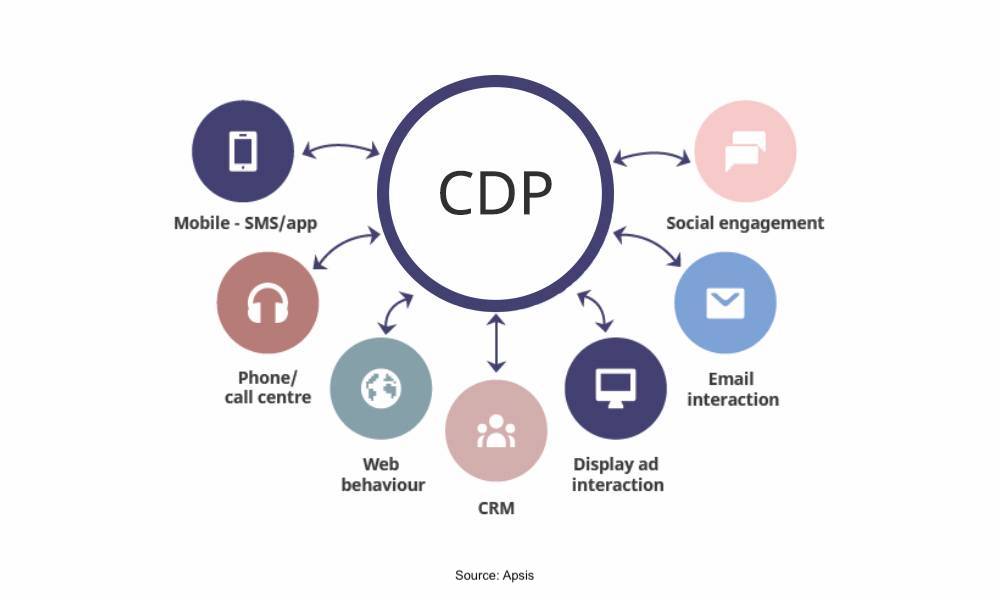The landscape of modern marketing is very dynamic. Staying ahead of the competition requires not only creativity and strategic acumen but also a deep understanding of customer behavior. Besides, we live in a digital era. The new currency is data, so harnessing the power of customer information is paramount. Below, we will discuss what a customer data platform (CDP) is and discuss its benefits – eventually, understanding the value of CDP is crucial for engaging the target audience and ensuring business success.
Table of Contents:
What Is a CDP & Why It’s Important?

At its core, a customer data platform (CDP) is a centralized system that ensuring customer data management from various online and offline touchpoints. This approach makes it easier for marketers to create a unified and easy-to-understand profile for each customer. When arranged properly, CDP offers unparalleled insights into customers’ preferences, behaviors, and interactions with a brand. The benefits of implementing a CDP are multifaceted as they address the key challenges faced by modern marketers.
To begin with, a customer data platform empowers marketers to break down silos within their organization by consolidating data from disparate sources. Next, CDPs allow real-time data integration and processing, enabling marketers to respond to every market dynamic and customer preference. This functionality is very important in a fast-paced digital environment as it empowers businesses to adapt their strategies and capitalize on emerging opportunities. The result is a more responsive marketing approach that fosters customer loyalty, drives revenue growth, and optimizes ROI.
Besides, CDPs offer enhanced data accuracy and consistency that contribute to more informed decision-making. Marketers can rely on one reliable source of information to come up with strategic planning and make resource allocation more efficient. Lastly, the insights derived from a customer data platform empower marketers to analyze and measure their campaign results more accurately, optimizing future efforts for maximum effectiveness.
Benefits of CDP for Modern Marketers

Today, CDPs are indispensable marketing tools for navigating the complex landscape of customer engagement. As businesses constantly try to prioritize data-driven strategies, the role of CDPs becomes central to their success. Below are some of the top benefits of CDPs for modern marketers.
Unified Customer Profiles
A customer data platform makes it easier for marketers to consolidate data from various channels. Then, it puts this data into a centralized hub. Such a unified view provides an accurate and comprehensive profile for each customer. This way, marketers can understand their customers’ preferences, behaviors, and interactions across different touchpoints.
Personalized Marketing Campaigns
When customer profiles are carefully organized, marketers can come up with personalized and highly targeted marketing campaigns. CDPs empower marketers to tailor not only their messages and offers but also their content to individual preferences so that the relevance of their communication can increase and the overall customer experience is enhanced.
Improved Customer Segmentation
CDPs make it easier to implement advanced customer segmentation based on real-time data management. Marketers can create dynamic segments that adapt to changing customer behaviors, achieving more precise targeting. This results in effective marketing strategies and better engagement with specific audience segments.
Real-Time Data Processing
Modern marketing requires speed and since CDPs process and analyze data in real-time, they allow marketers to promptly respond to the changing market conditions or customer preferences. This is highly important for staying competitive and maximizing opportunities that arise.
Enhanced Cross-Channel Coordination
A CDP streamlines and coordinates marketing efforts across various channels, ensuring their messages and experiences are clear and easy to follow. So, CDPs can help create a cohesive brand image and avoid disjointed customer interactions.
Data Accuracy and Consistency
CDPs contribute to data accuracy and consistency by eliminating discrepancies and the many errors arising from siloed data sources. Since marketers can make decisions based on accurate information, they can create more effective campaigns and resource allocation.
Improved Customer Retention
When analyzing customer preferences and behaviors, marketers can proactively address customer needs and concerns. CDPs matter the most in developing strategies to enhance customer satisfaction and loyalty. As a result, they ultimately contribute to improved customer retention rates.
Optimized Marketing Budget
CDPs provide valuable insights into campaign performance, including financial ones. Marketers can analyze the impact of their efforts, see which are their most successful strategies, and allocate their resources more effectively. Eventually, this increases ROI and gives marketers better control of their expenses.
End Data Silos
Consolidated customer data integration from various sources into a CDP eliminates data silos. By gathering all customer information into a centralized platform, companies can analyze all customer interactions. This approach makes it easier for different teams within an organization to access all relevant data simultaneously. So they gain a more profound understanding of customer needs and behaviors.
Increase Revenue
CDPs enable marketers to use data thoughtfully so they provide personalized experiences that drive customer engagement and brand loyalty. According to McKinsey, personalization has the potential to lift revenues by 5–15%. At the same time, it increases the efficiency of marketing spend by 10–30%. By leveraging CDPs for tailored experiences, businesses enhance conversion rates to increase revenue.
Omnichannel and Personalized Customer Experiences
CDPs help companies combine data from all touchpoints, allowing the creation of dynamic and personalized experiences matching customer needs and behaviors. Providing actionable customer insights, they activate experiences across relevant channels, i.e., mobile, web, email, and social media. This ensures a consistent and personalized customer journey that adapts to evolving customer needs and behaviors.
More Efficiency
CDPs centralize data into one platform, reducing data gaps between departments and minimizing redundancy associated with data silos. Constant updates ensure up-to-date insights, as CDPs use artificial intelligence and automation to create experiences.
Improve Customer Experience
By turning unified data into Single Customer Views (SCVs), CDPs enable the creation of personalized content, which speaks directly to customer needs. Such a personalized approach demonstrates that a brand values its customers and can enhance not only retention or loyalty but also overall customer lifetime value (CLV).
One B2C and B2B Businesses Platform
CDPs offer benefits for both B2B and B2C marketing strategies. They provide a comprehensive understanding of customers. Real-time CDPs empower marketers to create profiles that encompass consumer and professional data. They enable teams to collaborate closely in personalizing experiences for any type of audience without manual workflows, advanced skills, or extensive IT support.
Better Analytics and Reporting
CDPs offer robust analytics and reporting capabilities. They allow marketers to measure their campaigns’ success with more precision. This way, it becomes easier to track key performance indicators, identify trends, and derive actionable insights for continuous improvement.
How to Run a CDP Campaign?
 ++
++
Running a customer data platform successfully requires careful planning, strategic execution, and a keen understanding of your target audience. Take a look at a few tips on how to successfully use CDP insights.
Define Campaign Objectives
Clearly outline the goals for using CDPs. Whether you want to increase customer engagement, drive sales, or enhance brand loyalty, if you have well-defined objectives, you will guide your strategy and measure success in no time.
Data Collection and Integration
Start by making sure that your CDP has access to comprehensive customer data. Integrate the data from various sources by including online and offline touchpoints. This way, you will create a unified customer profile that includes demographics, preferences, purchase history, and behavioral analyses.
Segmentation and Targeting
The segmentation capabilities of CDPs work to identify specific audience groups. Tailor your campaign messages and offers to the segments obtained, aiming for the direct sales effect. And, of course, ensure that you have relevant content that resonates with each group.
Personalization Strategies
Leverage the personalization power to improve customer experiences. Use insights from the CDP to customize content, communication, and recommendations for individual customers. Eventually, personalized campaigns help you develop stronger connections and increase customer engagement.
Multi-Channel Coordination
Plan how your campaign will be across different and various marketing channels – from email and social media to websites and mobile apps. Coordinate messaging and offers across any of these channels to create a consistent experience for customers as they interact with your brand.
Real-Time Triggers
Implement real-time triggers according to customer behaviors. For example, if a customer abandons their online shopping cart, trigger an immediate follow-up email. This email should contain a personalized offer to encourage the completion of the client’s purchase.
Testing and Optimization
Conduct A/B testing to evaluate different elements of your campaign. These elements could be messages, images, or CTAs. Analyze the results to optimize your campaign based on what insights you gained. Continuous testing and refinement ensure your campaign is effective and aligns with customer preferences.
Post-Campaign Analysis
Once the campaign closes, conduct a thorough analysis of how it was performed. Evaluate its overall effectiveness, identify where it can improve, and examine key learnings for future campaigns.
Conclusion
A well-implemented CDP campaign brings many positive benefits that impact a business. From increased customer engagement and retention to optimized marketing spend and real-time responsiveness, a CDP campaign’s results contribute to a more effective and customer-centric marketing approach. As CDPs eliminate data silos and enhance personalization, CDPs empower businesses to unlock their customer data’s full potential, drive engagement, facilitate revenue growth, and increase customer loyalty. Proper CDP management also facilitates sales forecasting – a topic we covered in more detail in a separate post, so give it a read if you want to take your sales efforts to the next level.






